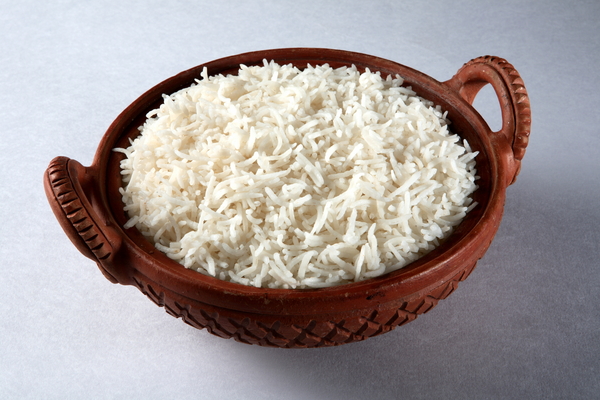Arsenic in Rice: Something to Worry About?

This week, news reports said that arsenic levels in juice may be unsafe, but experts say levels of arsenic in rice may be concerning as well, particularly for infants.
In fact, for people in the United States and Europe, rice is the largest dietary source of inorganic arsenic, said Andrew Meharg, chair of biogeochemistry at the University of Aberdeen in Scotland. Inorganic arsenic is a known carcinogen, and chronic exposure to low levels of arsenic has been linked to increased risks of bladder, lung and skin cancer, as well as Type 2 diabetes and cardiovascular disease.
The U.S. Environmental Protection Agency has set a limit for total arsenic in drinking water at 10 parts per billion (10 ppb); however, no such limit exists for food or beverages. Studies by Meharg suggest that eating about 3.5 ounces (100 grams) of uncooked rice would be the equivalent of drinking 34 ounces (1 liter) of water containing the maximum amount of arsenic allowed by the federal limit, Meharg said.
It's not yet clear how harmful the arsenic in rice may be to human health, but adults would likely have to consume quite a bit of rice over the course of decades for it to have an effect, said Christopher States, a toxicologist at the University of Louisville in Kentucky.
Babies, on the other hand, may be at higher risk for harm because they are more susceptible to the harmful effects of arsenic than adults, and baby cereal is rice-based, States said. A study published in Consumer Reports this week with the results of the organization's tests on apple juice also cited concerns about the levels of arsenic in rice cereal fed to infants.
Ultimately, more studies are needed to determine how arsenic in food affects human health, said Carolyn Murray, an assistant professor of community and family medicine at Dartmouth Medical School.
But some argue that, because we know even low levels of arsenic can cause harm, action should be taken now to limit the amount in our food supply.
Get the world’s most fascinating discoveries delivered straight to your inbox.
"We should be taking preventive measures, rather than saying 'let's leave this and see what happens'," Meharg said. "If we know it's of concern, we've got to act."
Arsenic in rice
Arsenic occurs naturally in the environment, and can also be present as the result of human activity, such as the use of arsenic-containing pesticides.
Rice plants are especially efficient at soaking up arsenic from their environment, both because of the plants' physiology and because the flooded areas in which they are often grown make it easier to take up arsenic compounds, Meharg said.
Research by Meharg has shown U.S. rice has some of the highest inorganic arsenic levels in the world, and that infant rice cereal sold here is generally made from U.S. rice, according to Consumer Reports. Still, the levels vary widely — rice grown in the southern United States contains particularly high levels of arsenic, while rice grown in other parts of the country, such as California, contains lower levels, Meharg said. Brown rice has been found to take up more total arsenic and inorganic arsenic than white rice, Meharg said
It's common for rice to contain 100 ppb of arsenic, Meharg said, though he has found levels as high as 2,000 ppb in rice bought in the United States and Japan.
Just how much rice you'd need to consume for it to affect your health is unknown. But roughly, it's thought that 10 grams of arsenic over a lifetime would increase the risk of diseases such as cancer, States said. Because levels of arsenic in rice are on the order of one-millionth of a gram, "You'd have to eat a ton of rice to get to 10 grams," States said.
The Food and Drug Administration (FDA) says it limits the amount of arsenic in drinking water because inorganic arsenic in some water supplies is a known public health problem. This has not been shown for other sources, including apple juice, the FDA says.
People also drink a lot of water. Even if levels of arsenic in rice exceed the limit set for water, you might not eat enough for it to be anything to worry about.
"In general, we drink a lot more water than we would probably consume [in rice]," Murray said.
Possible concerns
Inorganic arsenic present in baby food, on the other hand, may be a concern.
"Rice-based infant cereals are often the first solid food that babies eat," the Consumer Reports article said, and cited a 2008 study from U.K. researchers that found 20-ounce packets of dried infant rice cereal contained 60 to 160 ppb of inorganic arsenic.
Because babies are small, they can ingest more arsenic for their weight compared with adults. And exposure to arsenic may be particularly deleterious when it occurs at a time of rapid development, Meharg said.
Another concern is rice milk — vegans and others who consume rice milk may also be at risk for high exposure to arsenic, Meharg said.
In one study, Meharg and his colleagues found that 15 out of 18 brands of rice milk they tested had arsenic levels above the drinking water limit of 10 ppb. In the United Kingdom, the Food Standards Agency recommends rice milk not be given to children under age 4, Meharg said.
People who consume large amounts of rice — about 7 ounces, or 200 grams, a day — may also be at higher risk for health effects, Meharg said. The average American consumes about 0.3 to 0.5 ounces (10 to 15 grams) a day, Meharg said.
Is organic arsenic really harmless?
While much of the debate has focused on inorganic, or "bad," arsenic, research has shown that organic arsenic, while generally considered less harmful than the inorganic form, may not be as harmless as once thought. The FDA maintains on its website that "the organic forms of arsenic are essentially harmless," but others are not so sure.
"[It's] too simplistic to say that all organic arsenic is safe," said Carolyn Murray, an assistant professor of community and family medicine at Dartmouth Medical School.
The effects that organic arsenic has on human health likely depends on the food that is the source of it, Murray said. For example, fish can also be a source of the compound, and their bodies metabolize arsenic differently than rice plants do, she said.
Studies done in the late 1990s showed that high amounts of organic arsenic caused cancer in rats.
Studies show most of the arsenic in rice grown in the United States is in the organic form, States said. Meharg said the levels of organic arsenic in rice grown all over the world can vary widely, from 10 percent to 90 percent of the total arsenic.
Solutions
Governments should set a limit for the amount of arsenic that can be present in food, at least for babies, Meharg said.
For adults, a better approach may be to advise them how to minimize exposure to potentially unsafe levels of arsenic, Meharg said. Such a strategy would be similar to the one employed by the FDA to limit exposure to mercury in fish. (The FDA advises women and children to consume no more than two meals per week containing fish with low amounts of mercury, such as canned tuna.)
Meharg also suggested that farmers should grow rice in nonflooded conditions, so that the crop will not take up so much arsenic.
We're only at the very early stages of understanding just how much arsenic in food is too much, and what arsenic does to the body after it's ingested, Murray said. More research is essential to learn about these effects so better policy decisions can be made, Murray said.
Pass it on: Rice can contain levels of inorganic arsenic that surpass the limit set for arsenic in drinking water.
This story was provided by MyHealthNewsDaily , a sister site to LiveScience. Follow MyHealthNewsDaily staff writer Rachael Rettner on Twitter @RachaelRettner. Find us on Facebook.

Rachael is a Live Science contributor, and was a former channel editor and senior writer for Live Science between 2010 and 2022. She has a master's degree in journalism from New York University's Science, Health and Environmental Reporting Program. She also holds a B.S. in molecular biology and an M.S. in biology from the University of California, San Diego. Her work has appeared in Scienceline, The Washington Post and Scientific American.


